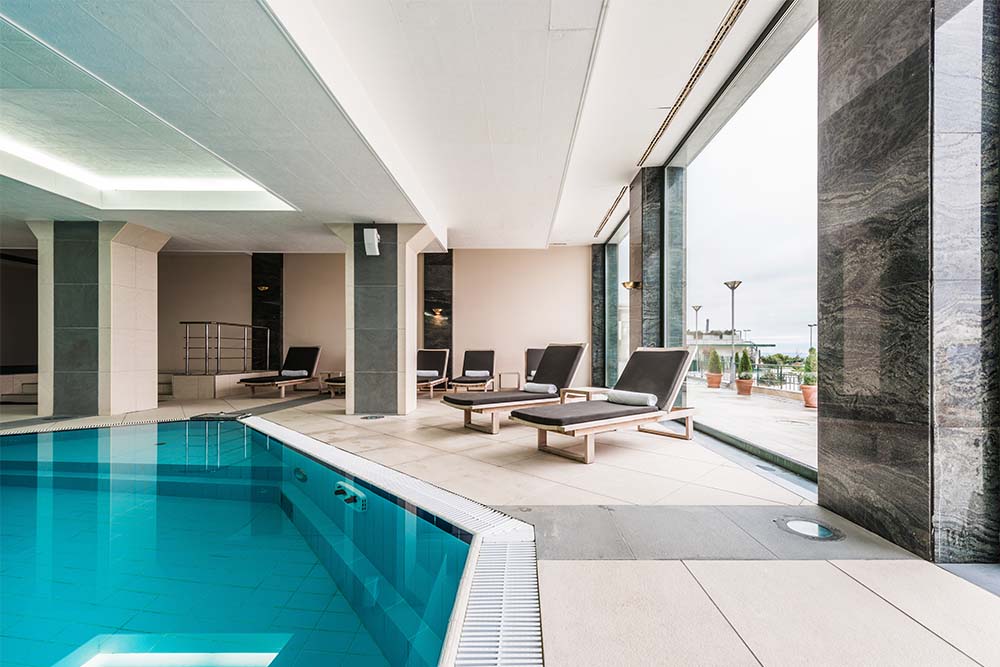Maintaining temperature in an indoor pool – both in the water and the facility itself – requires a thoughtful approach to heating and ventilation systems. Any pool environment is a delicate balance of cycles and processes, a constant dance of moving air and water that depends on multiple integrated systems.
Changes in temperature, both in the water and the surrounding air, can have dramatic effects on your dehumidification system. As the temperature increases, so does the evaporation rate of the pool’s water, which means more excess moisture that your dehumidifier will need to pull from the air. Maintaining a steady, comfortable temperature can help mitigate this, keeping the climate of your indoor pool less humid and more comfortable for guests without straining your dehumidification unit.
In this article, we’ll explore different strategies for controlling the temperature of an indoor pool facility and the pool water together. To do this, we’ll list just some of the many systems that can work together to create a pleasant, healthy swimming environment and provide a brief explanation for each one.
Pool Water Temperature Control Systems
Conventional Water Heating Systems
Gas Heaters: Gas heaters use natural gas or propane to heat water. They are quick to heat but may incur higher operational costs due to energy consumption.
Electric Heaters: These heaters convert electrical energy into heat. While they are easy to install and operate, they can also consume substantial energy.
Oil Heaters: Oil heaters use heating oil to warm the pool water. They are effective but may require more maintenance, which leads to them being far less common than other heating solutions.
Heat Pumps
Air-Source Heat Pumps: These pumps extract heat from the surrounding air and transfer it to the pool water using a refrigerant cycle. While they are very energy efficient, they tend to struggle with output.
Geothermal Heat Pumps: Utilize stable ground temperatures to heat the pool water. They are highly efficient, but can be costly to install and maintain, often requiring a specialist technician and unique parts.
Solar Heating Systems
Solar Panels: Solar panels capture sunlight and convert it into energy and heat for indoor pools. This method is becoming increasingly popular, as it’s both environmentally friendly and can significantly reduce operating costs over time.
Pool Covers: These pool covers trap heat from sunlight and prevent evaporation. This helps retain warmth and reduce the amount of excess moisture in the air.
Heat Exchangers
Plate Heat Exchangers: This method uses a boiler or other primary heat source to transfer heat to the pool water without direct contact. They can be very energy efficient, being able to derive power from different kinds of energy sources.
Common Methods of Pool Facility Temperature Control
HVAC Integration: Coordinate pool heating systems with building HVAC systems to maintain consistent indoor air and water temperatures, as well as controlling ventilation and regulating air quality.
Smart Controls: Utilize smart technology to remotely monitor and adjust pool temperature settings for optimal comfort and energy efficiency. Using tools like Seresco’s WebSentry can give pool operators unparalleled, integrated control of the pool environment from anywhere.
Variable Speed Pumps: These systems allow operators to control water flow rates to optimize heating efficiency and maintain consistent temperatures.
Insulation: Proper insulation of pool walls, floors, and ceilings can minimize heat loss and improve energy efficiency. This can also create less variability in room temperatures, which can make evaporation and humidity more predictable and steadier.
Want to talk to an expert about your indoor pool dehumidification needs? Contact us today!
